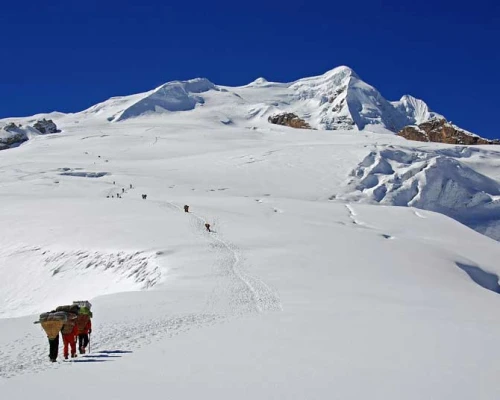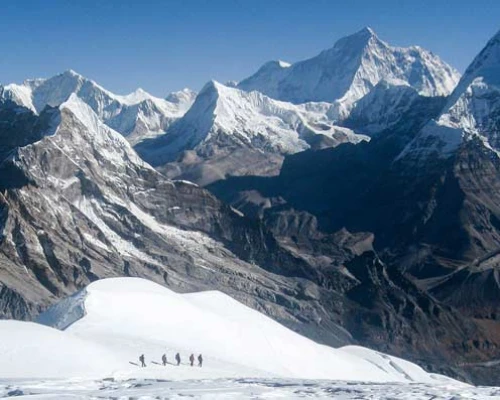Mera Peak Climbing is one of the most alluring climbing peaks in Nepal. It takes the climbers to the summit of Mera Peak(6561m), which is the highest climbing peak in Nepal. Situated in the east of Mt.Everest in the Khumbu region, Mera Peak contains three summits. Mera Peak North(6476m), Mera Peak Central(6461m), and Mera Peak South(6065m). Mera Peak is the best option for those looking for their first climbing experience in the Himalayas of Nepal. It requires basic mountaineering skills to tackle the high-altitude glacier crossings. However, it is technically less challenging when compared to other peak climbing, such as Island Peak Climbing.
One of the major highlights of the Mera Peak climb is the captivating views of mountains and valleys from its top. The peak unfolds the spectacular views of eight-thousanders like Lhotse(8516m), Cho Oyu (8201m), Makalu(8485m), and Kanchenjunga(8586m) and Everest(8848m), along with other surrounding peaks. Moreover, a walk through the charming villages, frozen waterfalls, dense forests, paddy fields, and amazing glaciers makes your climb to the Mera Peak more exciting and memorable.
Getting there
There are mainly three different routes to reach the Mera Peak summit. With the variation in the pathways, each route is different on its own. Further, the variation in the routes also comes up with making the Mera Peak Climbing easy or difficult.
Route 1
It is considered the shortest and most direct route to Mera Peak. Choosing this direct route to Mera Peak, you will not get enough time for acclimatisation, which may result in potential health problems during your trip. Even experienced climbers consider this route a challenging one. Hence, if you are a novice trekker, then it is recommended to avoid this route.
This shortest and most direct route to Mera Peak commences with a thrilling and wonderful flight from Kathmandu to Lukla. From Lukla, you trek through Zatra La Pass (4610m) to Tagnag to join the Mera Base Camp. Gradually ascending from the base camp, you reach the High Camp and then to the summit.
Route 2
It is the common route that follows the Everest Base Camp Trek route up to Namche Bazar. From Namche Bazar, you diverge your trek to Mera Peak. Trekking through the various ethnic and beautiful villages in the Everest region, you reach Mera Base Camp. Ascending from the base camp, the trail takes you to the High camp, and further hiking from there, you reach Mera Peak.
By choosing the trekking route, you will get to spend long days on the route. As a result of this, you will get enough time for acclimatisation. And spending enough time for acclimatisation reduces health complications. Also, following this trial, you get enough time to explore the Sherpa villages.
Route 3
It is the most common route for Mera Peak Climbing. Following this trek route results in the reduction of health risks, as this is quite an easy route, and you also get enough time for acclimatisation en route.
Starting from Lukla, the trek continues to Paiya, a village in Solukhumbu, to reach Hinku Valley. Further trekking through the villages like Pangaun, Nagindingma, and Kothe, the trail leads you to Tagnag. From Tagnag, you trek to Khare, which will lead you to the Mera Base Camp.
Following the 2nd and 3rd routes, you get the proper time to adapt to the changing altitude and weather conditions.








